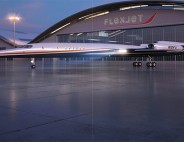Aerospace Embraces Expanding Spaces
20 Feb, 2014
By David Hodes
Industry remains strong even as funding uncertainty challenges growth planning.
The aerospace industry is dependent on enterprise activity historically based in the military or otherwise funded by government entities associated with the U.S. Department of Defense. The recent cuts in military spending in the form of sequestration have had a ripple affect across the entire industry in the last year.
What those cuts really mean to the industry— and what companies will be affected most — are still uncertain in the back and forth discussions at high levels in the U.S. government.
For a big industry such as aerospace, juggling fewer funds can be a tricky balancing act dramatically affecting a state’s economic health. The trick is to try to get ahead of a game that features a constantly changing set of rules.
Those coming budget cuts have had aerospace and aviation companies downsizing for months, while at the same time innovating next generation developments that promise to change how this country competes. Industry is also reviewing the new tools available for practical science discoveries — ranging from innovations such as delivering books via drones to the complicated innovations leading to landing payloads on the planet Mars.
In the face of uncertainty, companies and economic developers are getting creative.
Steven Kratz, director of communications for the Pennsylvania Department of Community and Economic Development (DCED), says that Lockheed Martin will lay off approximately 1,000 employees in Pennsylvania as part of its “local consolidation” based on loss of funds.
Lockheed, the nation’s largest military contractor, announced in late 2013 plans to lay off more than 4,000 employees across the country during the next two years. The Lockheed plant in Newtown, Pa. is one of four across the country to be shuttered. “But we have instituted certain business improvements,” Kratz says.
Among the business improvements the state now offers are a sales tax exemption for the fixed-wing aircraft parts and maintenance businesses (a similar tax exemption is already in place for helicopters), which state leaders project will create a good number of jobs that they have been losing to other states, Kratz says.
The DCED’s plan is to be better organized to deal with the effects of the sequestration. “One of the things that we did is change the way that manufacturing activities are taxed in the state,” says Mike Cortez, senior advisor to the secretary of the DCED. “In addition, we had a discussion about the connection between the aerospace industry and the downsized military installations that are reducing the amount of work they are getting from the Department of Defense. And if there are displaced workers, we got the facilities to start to be built in those former installations and train displaced workers for the aviation industry.”
Pennsylvania – along with 22 other states – was pursuing a contract withThe Boeing Co. for the construction of Boeing’s 777X, hailed as the largest and most efficient twin-engine jet in the world with orders totaling $95 billion immediately after its 2013 product launch. While Seattle won the contract in early January 2014, Kratz notes Pennsylvania has 6,000 Boeing-related workers in the state. “The odds of us getting that contract were not really that great,” Kratz says. “But we felt that because of Boeing’s large presence here, and because of them being the large company that they are, we want to make sure that we were top of their mind for any future projects that they are looking at doing.”
O, Canada
Up north in eastern Canada, in Miramichi, N.B, the city is working to create a commercial air center boomtown out of what was one of the few remaining air force bases in Canada, the Canadian Forces Base Chatham. The base was closed in the 1990s and a portion of it was turned over to the city. “We stopped maintaining a certain portion of it,” says Jeff MacTavish, director of economic development for the city, “But we didn’t decommission it.”
He says that the city conducted studies and realized that there was a need in eastern Canada for the type of service that this airport represented — a jumping off point to destinations in Europe. And the timing is right.
Trade barriers are set to fall between Canada and the European Union sometime in early 2015 as a result of the Comprehensive Economic and Trade Agreement, which will eliminate most of the tariffs between Canadian and European trade. Now, MacTavish says, there is a real advantage to flying and landing in Miramichi to take goods to and from Europe. “And we are going to be serving other areas in North America as well, offering them more access to Europe,” he says.
Beyond their current charter business, the airport is open to other clients as well, such as seafood distributors. “There is a tariff on seafood now coming from the states or Canada,” MacTavish says. “But the American companies can set up a distribution center here, ship out of Canada in the future, and might be able to save 7 percent off their bottom line that way — with the potential of hitting a market of 800 million people that were really price restrictive before.”
Back in the United States
Charter flights are also the bread and butter of another northern region’s airport — Michigan’s Capital Region Airport Authority in Lansing, where the authority has invested more than $25 million in airport facilities and services in recent years.
Bob Selig, executive director of the authority, says that the authority just finished its strategic plan for the port that includes the development of a 110-acre global logistics park.
In 2013, the authority completed the construction of a 48,000-square-foot warehouse in the park and recruited two international freight forwarders, including EMO Trans Customized Global Logistics in February.
The airport offers reduced fees compared to Detroit or Chicago air cargo zones, Selig says. But there’s more to consider. “You get improved delivery times for your customers because we don’t have the level of congestion that you experience in a Chicago,” Selig says. “Our operating mode is that if a shipment comes into Lansing, we have a commitment to deliver that within 500 miles of Lansing using same day or next day.”
Port Lansing can designate a foreign trade zone in any manufacturing facility — a duty-free subzone.
What’s Next?
Economic developers who are working to overcome budget issues, with sometimes outside-the-box solutions that create new opportunities for their respective cities or regions, are putting into practical application the products of an industry that has always been driven by dreamers.
Perhaps connecting more with the average Joe is Amazon.com founder Jeff Bezos, and his demonstration of unmanned aerial systems (UAS) delivery of products in a recent CBS “60 Minutes” report.
That television demonstration revealed what the Aerospace Industries Association (AIA) already knew — the systems are the new hot commodity in practical aviation invention.
In fact, the FAA recently announced six test sites where research can be done in a very controlled environment to understand the mechanics of integrating unmanned systems into the national airspace system. The test sites were required by the FAA Modernization and Reform Act of 2012; testing will continue until 2017. Congress has mandated UAS integration into the national airspace system by 2015.
The main sites – in Alaska, Nevada, New York, North Dakota, Texas and Virginia — are widely spread across the country to incorporate a number of different altitudes and terrains to give developers a sense of the disparate kinds of environments. Officials from the selected sites will also partner with other organizations to conduct their research. For example, Alaska will team with groups from Oregon and Hawaii on their research.
“UAS are already operating in the national airspace under very strict conditions and that is not likely to change,” says Dan Stohr, director of communications for the AIA. “But what this is doing is testing the integration of commercial or civilian applications.”
As an example, Stohr says that UAS can be used for severe weather monitoring, going where piloted vehicles can’t go. Firefighters, border patrol and law enforcement officials are all looking at applications of this technology, he says. “There is also a big push to get commercial UAS into agriculture. Since they can hover, they allow a user to determine exactly where there needs to be irrigation or where to spray pesticides. So this type of precision agriculture represents a great savings in time and materials.”
Space Travel
While this type of next generation aircraft works through FAA considerations and ramps up manufacturing, commercial space developments are exploding, with private investors circling new opportunities for cargo delivery and space tourism.
As reported in the December 21,2013 issue of The Economist, a space business cluster has developed in the Mojave Desert in California, the Mojave Air and Space Port, where 17 rocket and space-related companies operate, launching satellites for the most part, but also building toward greater commercial ventures.
NASA is very keen on getting the commercial crew program together, Stohr says. “They have just basically completed the commercial cargo portion of the commercial space effort with the certification of two companies to fly cargo. The next step of that program is to get a crew-rated capsule. And there are quite a few things that can potentially come out of that — such as a concentration on deep space exploration.”
The sequestration, which, minimized in 2013, is still creating a cloud of uncertainty for the next couple of years, has hit the DoD and military aircraft sales hardest. But NASA has also taken a hit. It could mean that the 2014 NASA budget may be around $16 billion, down $2 billion from 2011. “And that is a real problem in terms of NASA executing its mission,” Stohr says.
Regardless of budget cuts and the juggling of funds, the aviation industry is one of this country’s strongest.
The AIA reports that worldwide demand for next generation commercial aircraft is huge. The total backlog for U.S. civil transport aircraft totaled 4,787 aircraft worth $344 billion. Production of next generation 737s will increase to 42 aircraft per month in mid-2014 and to 47 per month in 2017. And by 2022, the global maintenance, repair and overhaul market will nearly double to $84.7 billion.
Still, the nagging uncertainty has been cause for distraction. “You can’t keep cutting and cutting and expect us to do more with less,” AIA president and CEO Marion Blakey said at a recent industry year-end review.
For more information on the organizations mentioned in this article, visit:
Aerospace Industries Association
Capital Region Airport Authority in Lansing (Mich.)
Pennsylvania Department of Community and Economic Development
Illustration by Salvatore Vuono at Free Digital Photos.net















